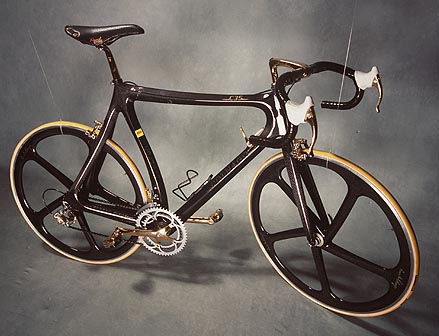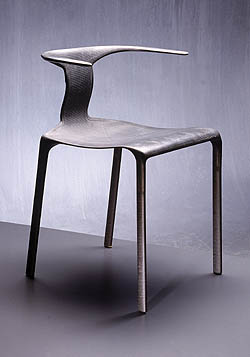|
The Superbike has a special frame (monocoque), designed and
made in Australia, while the remaining components, disc wheels,
cranks, pedals, seat, chain etc., were made by the Italian
company, Campagnolo, of Vicenza, Italy. This company is also
a sponsor of the Australian Olympic cycling team.
| Monocoque
|
The
carbon fibre–polymer composite monocoque was shaped
to reduce aerodynamic drag. |
|
Handlebars |
The
conventional handlebars have been eliminated. Carbon fibre
handle grips are attached directly to the wheel forks. |
|
Weight |
The
lightweight frame (the bicycle weighs only 5 kg) provides
extra strength between the seat and pedals where the main
power is exerted. |
The
sweeping line of the Superbike optimises the aerodynamic shape
which, combined with the lightweight carbon fibre shell, requires
15 per cent less power to travel at a given speed than a conventional
tubular-framed racing bike.
Place
your mouse pointer over parts of the bike to find out more.
Materials
The choice of using carbon fibre technology, an area where
RMIT has special expertise, was an obvious one. Carbon fibre
components were already in use in other sporting equipment
where lightness, strength and stiffness were crucial, for
example in sailing skiffs. Thompson was determined from the
outset that the product which his team created should be suitable
for mass manufacturing, but at the same time it should have
exceptional quality and precision.
The
use of carbon fibre construction enables any shape to be formed.
Maximum strength is achieved with a minimum amount of material.
Carbon fibres have excellent strength and rigidity. This is
why carbon fibre is used so widely in space programs and Formula
One motor racing.
Production
of carbon fibres
| Carbon
fibres are produced by carbonising (heating to a very
high temperatures, but in the absence of oxygen to prevent
burning) organic fibres such as acrylics or high-strength
regenerated cellulose fibres. Precise control of carbonising
temperatures (up to 3000°C) determines the physical
properties of the resultant carbon fibre. (Fritz, 1986:
178) |
 The
Colnago C-35 bicycle is a hand-made, Italian bicycle,
with carbon fibre monocoque frame and forks developed
by Colnago and Ferrari. Known as the 'Ultimate', this
unique bicycle also features gold-plated components.
Powerhouse Museum Collection. It was presented to the
Powerhouse Museum by Mr David Greatorex AO in 1995.
The
Colnago C-35 bicycle is a hand-made, Italian bicycle,
with carbon fibre monocoque frame and forks developed
by Colnago and Ferrari. Known as the 'Ultimate', this
unique bicycle also features gold-plated components.
Powerhouse Museum Collection. It was presented to the
Powerhouse Museum by Mr David Greatorex AO in 1995. |

The
Lightlight experimental chair demonstrates the
use of carbon fabrics in an epoxy resin mould with unidirectional
meshing in carbon to achieve a useful, comfortable and
very light chair. It was designed by Alberto Meda and
made by Alias of Italy in 1987 and is an example of one
of the first applications of composite materials in the
furnishing industry. Powerhouse Museum Collection. It
was purchased by the Powerhouse Museum in 1989.
|
Activity
1. Outline the principles of monocoque construction.
2. What specific qualities does carbon fibre have that makes
it appropriate for use in this application?
|
![]()
![]()
![]()